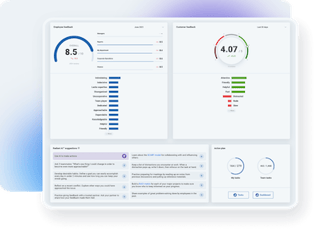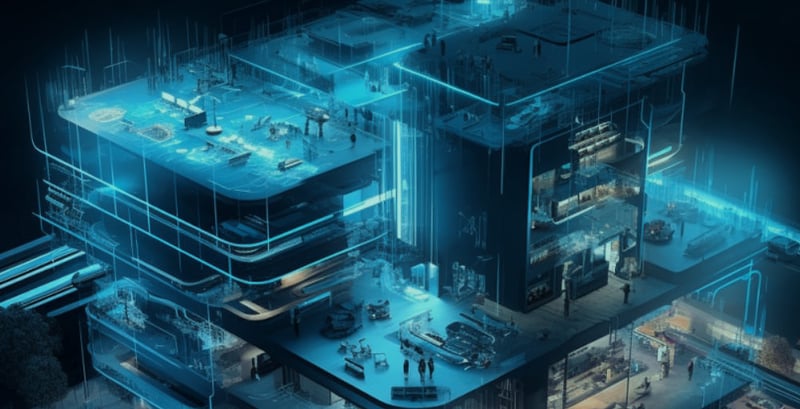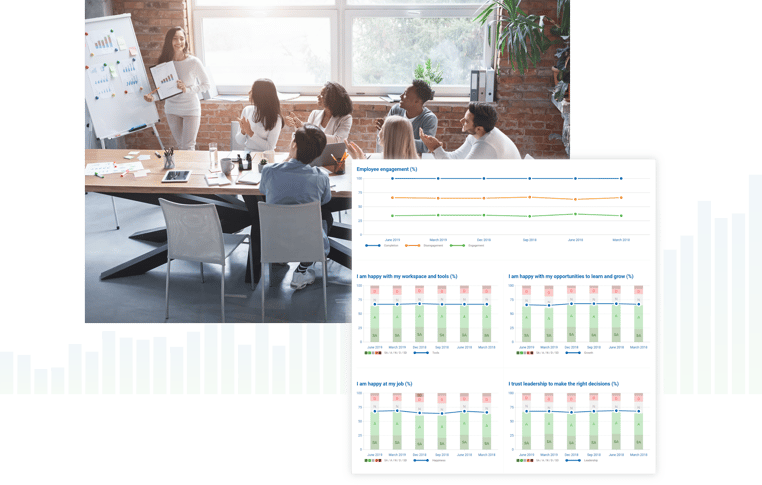
The Generative AI Advantage: How to Responsibly Amplify Workplace Productivity
Navigating The Rise of Large Language Models and ChatGPT
This cutting-edge form of artificial intelligence (AI) can create entirely new content, from text and images to music. Generative AI is powered by large language models (LLMs), which have been meticulously trained on vast datasets of text and code. LLMs can be playfully used to generate pirate-themed poetry, which adds a touch of fun. However, their true strength is revealed when they're employed as a business tool. With the capacity to instantly review dozens of pages of materials, they can meticulously create comprehensive legal briefs, financial reports, or even insightful employee performance reviews.
In this blog post, we will discuss the following:
- How generative AI and LLMS are different from ChatGPT
- How generative AI can amplify workforce productivity by 2x to 4x
- A real-world example: How we designed Radiant AI to automatically and securely generate performance management documents
Groundbreaking innovations such as electricity, computers, and the internet required decades to ripple across the globe and redefine our world. Yet, the advent of generative artificial intelligence (AI) is swiftly reshaping this historical narrative of technological evolution.
Thanks to the power of cloud computing, generative AI is being adopted at an unprecedented pace. It’s accessible to everyone from the largest corporations to sole software developers. In months to years, generative AI will have a transformative impact on our world. Businesses that quickly adopt generative AI will see a massive increase in market cap, while those who lag behind will be left behind.
-
What are LLMs, Generative AI, and ChatGPT?: Large language models (LLMs) are the underlying technology that powers ChatGPT. LLMs are the latest generation of AI tools, possessing an extraordinary ability to comprehend and produce text. This marks a notable evolution from earlier AI models like sentiment analysis tools, which mainly interpreted emotional tone. LLMs are a versatile tool that have diverse applications. However, this also means they can be difficult to extract the best results and can potentially be misused or misunderstood, signaling a need for responsible use and a robust understanding.
Why Everyone’s Talking About ChatGPT: A Revolutionary Leap in AI
In a stage of my career, I worked on developing new medical devices. However, I was frustrated by the slow pace of progress and adoption. I decided to start a company that used AI to bridge the gap between employee and customer feedback. Traditional AI technology has been helpful, but the recent development of user-friendly and powerful LLMs has fundamentally changed the landscape. This blog post is the first in a series that will discuss how LLMs can be strategically implemented in software to significantly improve employee productivity.
ChatGPT has marked a significant turning point in the realm of AI. Even though LLMs have been around for a while, the convenience of interacting with one of the most advanced models on a website has quickly demonstrated the strength of this cutting-edge technology to the world. ChatGPT's user-friendly interface and advanced capabilities have made it a popular tool for both businesses and individuals.
- Technological Quantum Leap: ChatGPT represents a significant stride in the field of AI. Its nuanced understanding of language and superior generation of text have marked a novel era in the AI landscape. It’s so revolutionary, over 100 million people used it in the months after it was released.
- User-friendly Design: ChatGPT emphasizes engaging communication, responding to user prompts with insightful and relevant text. This seamless user interaction is a groundbreaking change from previous AI models. Designed for ease of use, ChatGPT requires no setting adjustments, no code compilation, and no server configuration. Users can simply input a prompt or question, and ChatGPT will reply with relevant, informative text.
- Blending Functionality with Fun: Not just a business tool, ChatGPT can transform ordinary conversations into engaging and creative exchanges, adding a layer of enjoyment to its practical use. It can write poems and songs, and it can tell (usually bad) jokes. It demonstrates an understanding of language that people thought would take decades for computers to achieve.
Generative AI: A Powerful Tool with a Dark Side
While ChatGPT’s rise has stirred considerable excitement, it has also raised apprehensions and anxieties:
- Impact on the Job Market: The swift pace of AI advancements often sparks fear of job displacement. The advanced capabilities of ChatGPT have only amplified these concerns. Overnight, we went from thinking we might never see this advanced language technology in our lifetimes, to it being freely accessible to billions. If a computer can generate amazing documents in a few seconds, what could happen to writers? Lawyers? Marketing professionals? Can this be genuinely useful, is it just a fun tool, or is it somewhere in between
- Wait, computers can hallucinate?: Millions of people quickly discovered that ChatGPT can write like a pro, but sometimes it confidently pulls facts from thin air. This phenomenon is known as “hallucination”. Hallucination occurs when an LLM generates text that is incorrect or nonsensical. For example, Google’s chat-focused LLM, Bard, once told me that bears hatched from eggs. Hallucination can be a serious problem, especially if you need to rely on LLMs for your business.
- Potential for Misuse: Misuse of AI tools like ChatGPT is a serious concern. AI can spread misinformation, violate privacy, create biased systems, and launch cyberattacks. It is important to be aware of these risks and to take steps to mitigate them, such as developing ethical guidelines for the use of AI, ensuring that AI systems are transparent and accountable, and educating the public about the potential risks of AI. Again, these are problems we thought we wouldn’t have to face for decades, and now they’re at the front and center of technology discussions.
ChatGPT in the Office: The Concerns Prompting Corporate Bans
If LLMs are as incredible as they seem, then why do we hear about companies prohibiting the use of ChatGPT? When we learn that employees at Apple and JPMorgan Chase aren't allowed to use ChatGPT, does that mean generative AI won't bring about massive changes, or is there an issue with the tool itself? Despite its remarkable abilities, ChatGPT brings its own set of challenges in a professional environment:
- Security Concerns: ChatGPT is designed to learn and create responses based on its training data. While this aids its learning process, it could potentially risk revealing sensitive information, creating security concerns. For instance, if ChatGPT is employed to draft text for a marketing campaign, it might unintentionally disclose confidential details about the features of a product yet to be launched.
- Fact or Fiction: Sometimes, ChatGPT may generate text based on misinterpretations or fabrications, as we discussed above, also known as ‘hallucinations’. This can lead to misleading or inaccurate outputs. If ChatGPT is used to generate a response to a customer complaint, it may include completely wrong information that frustrates them and makes them think twice about repeating their business.
- Nobody talks about how hard it is to make a good prompt: Crafting effective prompts for ChatGPT demands comprehension and skill. This can be challenging for employees, leading to less-than-ideal or erroneous usage.If an employee creates a vague or overly specific prompt, they may get misleading or off-target output. What was meant to boost productivity could instead lead to wasted time and frustration.
- Large Scale Errors: Incorrect or misguided use of ChatGPT can result in confusion or misinformation, impacting operations at a large scale due to the model’s expansive reach. For example, if ChatGPT is used as part of a customer service procedure, it may work great 80% of the time, but result in wrong statements to 20% of your customer base.
- How do we test this again?: In a business setting, users need to know that the underlying model of a generative AI tool may be updated overnight to improve performance. To ensure consistent results, users need to rigorously test the model with a variety of different inputs. For example, a company using ChatGPT to generate text for customer service interactions should test the model with a variety of different customer requests. Additionally, the company should monitor the model's performance over time to ensure that it continues to meet expectations.
Overall, ChatGPT is a powerful tool that can be used in a variety of ways in the workplace. However, it is important to be aware of the risks associated with using LLMs and to take steps to mitigate them. By understanding the potential risks, businesses can use LLMs safely and effectively.
Productivity Amplified, Problems Nullified: The Art of Crafting Effective AI Tools
As Macorva started thinking about using generative AI in nearly every part of our interface, we knew we needed to develop some general guidelines. Creating an ideal AI application—one that maximizes benefits and minimizes drawbacks—requires careful planning and strategic implementation. Here are our guidelines:
- A Summarizer, Not a Decision Maker: AI should act as a facilitator, helping digest and summarize complex information. It shouldn’t replace judgment or invent new information. Setting this boundary can help keep AI as a helpful tool, not an unregulated decision maker. For example, AI can be used to summarize large amounts of data, identify trends, and generate insights. However, AI should not be used to solely make decisions.
- The Power of Adjustable Settings: ChatGPT stands out due to its simplicity and user-friendly interface. Simply type your query, press enter, and voilà – an impressive response is generated. However, LLMs offer a plethora of adjustable settings and fine-tuning parameters that can guide their output. By tweaking these advanced options within LLMs, software developers can generate output that’s significantly more aligned with their objectives compared to using a general-purpose tool like ChatGPT.
- Extensive Testing: Every AI operation must be rigorously tested over several months. This ensures that the large amount of data fed into the AI is properly formatted and understood. This is crucial, as only then can the AI effectively generate valuable outputs. At Macorva, we test every use case thousands of times. We use different prompts, different input data, different ways of parsing the input data, and at least three different foundational LLMs. This helps ensure consistent output, even though the tools are changing rapidly. Additionally, AI systems must be tested for bias and accuracy.
- An Efficient Jumping Off Point: AI should act as a starting point. It can generate a first draft, which can then be edited and refined by people who are experts at their jobs. This ensures high-quality final outputs while saving substantial time.
- Data Security: Using secure APIs and following standard frameworks like SOC 2 can enhance data security, helping mitigate the risks associated with data breaches and misuse. AI systems should only be given access to the data they need to perform their tasks. Additionally, AI systems should be encrypted to protect their data from unauthorized access.
- User-friendly Design: AI tools should be designed with ease of use in mind. The tool should handle complex tasks behind the scenes, while providing users with a simple interface. This approach ensures high-quality results without burdening users. If users need to understand best practices for working with LLMs, the tool has already failed. The best tools produce high-quality results without requiring any special instructions. Employees don't need to learn another new technology.
By following these principles, we can create AI systems that increase productivity, raise the quality of work, and avoid the pitfalls of casual AI usage.
Reshaping the Business Landscape: We’re About to See Massive Impacts Due to Generative AI
Now that we understand the massive power of LLMs for business and personal use, what changes can we realistically expect to see? If LLMs can do amazing things, but we want to increase productivity without upskilling our workforce, what does that actually look like? The integration of LLMs into business operations will drastically redefine the business landscape:
- Redefining Software Tools: Every software tool that contains or creates text or unstructured data must fully embrace LLMs to stay relevant and competitive. Failing to do so can lead to an enormous decline in efficiency and productivity. For example, a customer relationship management (CRM) software that incorporates LLMs will be able to automatically send an email every morning of the new deals that are at risk of being lost without quick action. If their competitors don’t catch up quickly, their market share will rapidly shift.
- Unleashing Business Potential: Businesses that depend heavily on creating standardized documents or summarizing a lot of information need to transition to tools that fully leverage LLMs. Doing so can dramatically increase productivity, often by 2x to 4x. For example, a legal firm that uses LLMs to generate contracts can save a significant amount of time and money.
- $10 Trillion Market Cap Realignment: Over the next 1-3 years, we can expect a major shift in market capitalization. Companies that do not effectively harness the power of LLMs will lose out to those that do, resulting in a transfer of trillions of dollars. LLMs are a powerful tool that can be used to improve efficiency, productivity, and customer satisfaction. Companies that fail to adopt LLMs will be at a competitive disadvantage in the years to come.
- Accelerated Transitions: Thanks to cloud computing, these advanced systems are accessible to everyone, regardless of their scale of operations. This widespread accessibility will expedite market shifts, disrupting traditional market dynamics at a faster pace than anticipated.
The integration of LLMs into business operations is already having a significant impact, and this impact is only going to grow in the future. Businesses that fail to embrace LLMs will be left behind, while those that do will reap the rewards of this new technology.
Real-World Example: Reimagining Performance Management with Radiant AI MX
Macorva has always used AI to help companies close the feedback loop with their data. In the past, we relied on action items pre-generated by a team of I/O psychologists and executive coaches. While this was a big step forward, it was impossible to pre-define every path a manager might need to help employees.
Macorva has now revolutionized performance management with LLMs. LLMs are able to save time, produce high-quality documents, and provide consistent results. They can also quickly do tedious work that traditionally takes dozens of hours, such as sorting through meeting notes, performance reviews, survey results, and 360 feedback. Most importantly, this is the type of work that most managers hate to do.
Radiant AI Manager Experience (MX) leverages a vast feedback database and amalgamates it with managerial insights to transform performance management and managerial enablement. It does this by unifying structured and unstructured data, personal insights, and corporate documents to yield an all-encompassing suite of performance management deliverables.
We had these core objectives in mind while designing Radiant AI MX:
- Data Integration: MX uses all of the data your business is already collecting, like employee surveys, 360s, NPS, eNPS, and customer feedback. This allows for a more holistic view of employee performance and helps to identify areas for improvement without the need for implementing additional programs or training employees to use a new tool.
- Personal Touch: Your managers have amazing insights, but probably hate staring at a blank page and writing a detailed performance document with dozens of meticulous references. MX allows managers and employees to add their personal insights in a relaxed and informal manner. The focus is on the insights, making the process more intuitive and less formal.
- Personalized development plans: MX creates personalized development plans for each employee, based on their individual strengths and weaknesses.
- Continuous feedback: MX provides managers and employees with continuous feedback, so they can stay on track and make continuous improvements. This is done by closing the feedback loop of data that your business is already collecting, but probably not doing much with.
- Real-time coaching: MX offers real-time coaching to managers, so they can get help when they need it. And thanks to LLMs, we can test and train on an enormous variety of corporate issues, and not have to pre-define every scenario.
- Streamlining Performance with Company Objectives: Incorporation of corporate documents such as annual goals provides a comprehensive view of the company’s objectives, aligning individual performance outputs with overall corporate goals. This helps to ensure that employees are aligned with the company’s strategic direction and that their performance is being measured against relevant criteria.
- Instantly Empowering Managers: The AI’s design promotes managers’ active engagement in editing the AI-generated documents. This not only saves considerable time but also ensures a level of standardization in the quality of documents produced. This helps to free up managers’ time so that they can focus on more strategic tasks.
Overall, Radiant AI MX is a powerful tool that can help revolutionize performance management and manager enablement. It integrates structured and unstructured data, personal insights, and corporate documents to provide a comprehensive suite of performance management outputs that are more accurate, engaging, and effective.
With Radiant AI MX, companies can save countless hours for managers by automating time-consuming tasks such as data entry and analysis. They can also enhance employee development and productivity by providing precise guidance and due recognition to every piece of feedback. Additionally, they can improve the overall performance management process by closing the feedback loop and providing a more holistic view of employee performance.
Conclusion
As we stand on the cusp of a new era, Radiant AI MX provides a great example of the path forward, demonstrating how we can exploit the unlimited potential of AI while carefully navigating its inherent challenges. The emergence of AI tools like ChatGPT represents a significant shift in how we interact with technology. By recognizing and addressing potential pitfalls, we can harness these advancements for our benefit, revolutionizing businesses, boosting productivity, and defining the future of work.
In our next installment, we’ll discuss how business leaders can assess new generative AI-enabled tools. We’ll cover how to distinguish between those that deliver on their lofty marketing promises and those that won’t move the needle for your organization. Your software evaluation process may need to change overnight, but those who adapt will be part of the winners in the upcoming generative AI generation.
To learn more about the Macorva MX platform, schedule a demo today.







